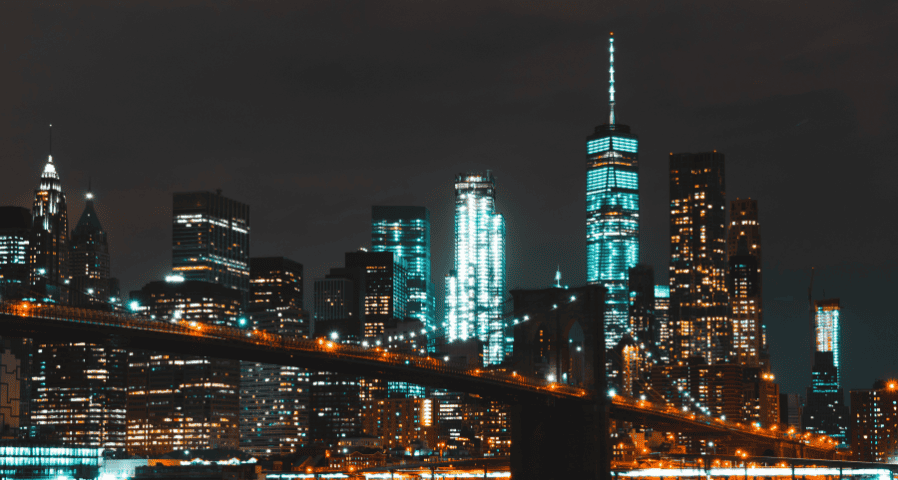Outdoor lighting plays an essential role in how communities’ function after dark by keeping roadways safe, illuminating public spaces, and creating a sense of security. Yet, poorly designed outdoor lighting can have unintended consequences: wasted energy, glare, and disruption of natural ecosystems. The DesignLights Consortium (DLC) recognized this challenge and introduced the DLC LUNA program to balance lighting quality, environmental responsibility, and energy efficiency.
What is the DLC LUNA?
DLC LUNA is a set of performance criteria developed by the DesignLights Consortium for outdoor solid-state lighting (SSL) products. Its purpose is to ensure that outdoor lighting at night supports human visibility and safety while minimizing light pollution and energy waste.
Products that meet LUNA standards are listed on the DLC’s Qualified Products List (QPL), a trusted resource used by municipalities, utilities, and lighting professionals to identify energy-efficient, dark-sky-friendly fixtures. These products also comply with the DLC’s rigorous SSL V5.1 requirements for efficacy, controllability, and quality, meaning they save energy while maintaining environmental balance.
Why Light Pollution Matters
At night, artificial lighting at night is one of the fastest-growing forms of pollution. It extends beyond city limits, brightening skies and affecting humans, wildlife, and entire ecosystems. The LUNA program directly targets several forms of light pollution:
Sky Glow
Sky glow results when artificial light scatters through the atmosphere, reducing visibility of stars and natural darkness. Beyond diminishing stargazing, it can interfere with circadian rhythms, wildlife navigation, and even agricultural cycles. LUNA addresses this by setting thresholds for uplight, dimming capability, and correlated color temperature (CCT).
Light Trespass
Light trespass occurs when illumination spills into unintended areas, such as residential windows or natural habitats. By emphasizing proper shielding and light distribution, LUNA-compliant products prevent unnecessary spillover while promoting both comfort and energy savings.
Glare
Glare is uncomfortable and hazardous. When light is too bright or poorly directed, it can impair vision for pedestrians and drivers. LUNA continues to collaborate with standards organizations to advance glare performance requirements that enhance nighttime visibility and safety.
The Environmental Dimension
The effects of artificial lighting extend deep into ecological systems. Many nocturnal species rely on darkness for feeding, migration, and reproduction. LUNA aims to reduce the ecological disruption caused by artificial lighting by promoting design practices such as:
- Using warmer light spectra to minimize biological impact.
- Incorporating controls like motion sensors and dimmers to reduce unnecessary lighting.
- Encouraging shielding to direct light only where needed.
This careful balance allows humans to illuminate their environments responsibly while preserving the health of local ecosystems.
Understanding DLC LUNA requirements is essential to maximizing your lighting project’s rebate potential. Explore our process to see how we simplify rebate management from qualification through recovery, ensuring every project meets compliance and achieves maximum ROI. Schedule a call with our experts today to navigate DLC standards with confidence and capture every available incentive.
Energy Savings Through Smarter Lighting
The International Dark-Sky Association estimates that nearly $3 billion in energy is wasted each year due to poorly designed lighting that contributes to sky glow. The LUNA program helps reverse this trend by requiring products that focus light only where and when it is needed.
Energy efficiency is built into the LUNA philosophy: each qualified fixture meets or exceeds DLC efficacy thresholds, supports dimming controls, and can integrate with lighting management systems to optimize performance. The result is lower operational costs, extended fixture life, and measurable progress toward sustainability goals.
Goals of the LUNA Program
The DLC LUNA program is built on three core objectives:
- Minimize light pollution by setting strict standards for uplight, CCT, and distribution, resulting in darker skies and reduced glare.
- Reduce lighting energy use by pairing high efficacy with advanced control options such as dimming and motion response.
- Provide appropriate nighttime visibility by meeting high-quality lighting criteria that balance safety, comfort, and environmental responsibility.
Who Benefits from DLC LUNA?
The program offers value across multiple sectors:
- Manufacturers gain distinction by offering energy-efficient, environmentally responsible fixtures.
- Utilities and energy-efficiency programs can integrate LUNA standards into rebate structures to meet savings goals.
- Cities and municipalities achieve compliance with dark-sky ordinances while maintaining safe public spaces.
- Designers and engineers can specify products that meet both performance and sustainability goals.
- Businesses and institutions enjoy reduced operational costs and improved outdoor environments.
How the LUNA Program Works
The DLC oversees LUNA through guidance from the LUNA Advisory Group, composed of lighting researchers, designers, and utility professionals. Their input ensures the criteria stay relevant as technology evolves.
Once a product meets LUNA’s stringent technical requirements, it earns qualification on the DLC’s Solid-State Lighting QPL and becomes identifiable by the DLC LUNA logo. This simplifies the process for buyers who want to ensure their outdoor lighting projects meet both energy efficiency and dark-sky standards.
Balancing Light and Darkness
Artificial lighting has enabled society to operate safely and productively after sunset, but it must be applied with care. The DLC LUNA program represents a path that acknowledges our dependence on outdoor lighting at night while protecting the natural rhythms that sustain life.
Through LUNA, the DLC provides more than a certification; it offers a framework for responsible lighting design meanwhile ensuring that our cities, roads, and communities can shine where necessary without drowning out the stars.
Financial incentives are available for businesses seeking ways to lower the cost of outdoor LED retrofits that meets the new DLC LUNA guidelines. Incentive Rebate360 can help you discover ways to maximize your savings and streamline the rebate recovery process. To contact us, call 480-653-8180, email [email protected], or schedule a call that fits your needs by clicking the button below!






0 Comments